Slovak crown (1993-2008)
| Slovak crown | |
|---|---|
| Country: |
|
| Subdivision: | 100 hellers (halierov) |
| ISO 4217 code : | SKK |
| Abbreviation: | Sk |
|
Exchange rate : (fixed) |
1 EUR = 30.1260 SKK |
The Slovak crown ( slovenská koruna ) was the currency of Slovakia from February 8, 1993 (shortly after the division of Czechoslovakia and the creation of independent Slovakia on January 1, 1993) to December 31, 2008 . One crown was divided into 100 Heller (halier) . On June 3, 2008, the Economic and Financial Affairs Council approved the introduction of the euro on January 1, 2009. The exchange rate that came into effect on January 1, 2009 was set on July 7, 2008 at SKK 30.126 / EUR. On January 1, 2009, the euro officially replaced the Slovak koruna as the currency; for a transition period until January 16, 2009, both currencies could still be used.
Banknotes
There were the following banknotes: 20 crowns, 50 crowns, 100 crowns, 200 crowns, 500 crowns, 1000 crowns and 5000 crowns. On the front there were personalities from Slovak history and on the back there were places associated with them. For the design, a proposal by Joseph Bubák was used , whose draft for an all- Czechoslovak note series was inferior to the CSFR.
| Value in SKK | Value in EUR | front | Description of the front | Description of the back |
|---|---|---|---|---|
| 20 Sk | € 0.66 |

|
Prince Pribina | Nitra Castle |
| 50 Sk | € 1.66 |

|
St. Cyril and Method | Church in Nitra- Dražovce and Glagolitic script |
| 100 Sk | € 3.32 |

|
Image of Mary in Levoča ( Paul von Leutschau ) | Church and town hall in Levoča |
| 200 Sk | € 6.64 |

|
Anton Bernolák | City of Trnava |
| 500 Sk | 16.60 € |

|
Ľudovít Štúr | Bratislava Castle |
| 1000 Sk | € 33.19 |

|
Andrej Hlinka | Church in Ružomberok |
| 5000 Sk | € 165.97 |

|
Milan Rastislav Štefánik | Tomb on the Bradlo Hill ( Brezová pod Bradlom ) |
Coins
There were the following coins: 50 heller, 1 krone, 2 krone, 5 krone and 10 krone
The former 10 and 20 Heller pieces became invalid on January 1, 2004 and were confiscated by the National Bank of Slovakia . 50 Heller coins continued to exist in two variants: an older “classic” aluminum chip and a newer, smaller coin made of copper-plated iron. Even before the introduction of the euro, however, 50 Heller pieces were rare in daily payment transactions.
As the retail trade continued to issue prices in 10-Heller intervals, the respective total amount was rounded up when the euro was introduced.
All coins were designed by Drahomír Zobek . They had the image of the Slovak coat of arms with the writing “SLOVENSKÁ REPUBLIKA” (Slovak Republic) and the year of embossing on the back; Description of the front as below:
| Value in SKK | Value in EUR | front | back | Description of the front |
|---|---|---|---|---|
| 10 h | € 0.0033 |

|
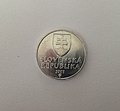
|
Eight-sided wooden bell tower from Zemplín |
| 20 h | € 0.0066 |
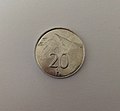
|
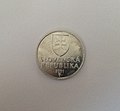
|
Kriváň mountain in the High Tatras |
| 50 h | € 0.0166 |

|
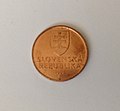
|
Devin Castle tower over the Danube |
| 1 Sk | € 0.0332 |

|

|
Gothic sculpture of an image of Mary |
| 2 Sk | € 0.0664 |
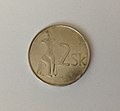
|

|
Seated Venus figurine |
| 5 Sk | € 0.166 |

|
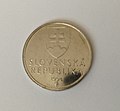
|
Reverse side of the Celtic coin Biatec |
| 10 Sk | € 0.332 |
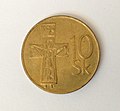
|

|
Bronze cross from Veľká Mača |
Exchange rate system
On November 25, 2005, Slovakia joined Exchange Rate Mechanism II (ERM II) without notice . About him the crown at 15-percent was bandwidth at a fixed central rate pegged to the euro. Initially, 38.4550 kroner per euro was set as the central rate. As a result of the continual appreciation of the krona against the euro, however, the Slovak central bank was forced to adjust the central rate in consultation with the EU ; therefore, a central rate of 35.4424 kroner per euro has applied since March 19, 2007. Since the strong appreciation of the krona continued, the central rate was adjusted again on May 28, 2008 to 30.1260 kroner per euro.
On May 7, 2008, the European Commission recommended the introduction of the euro in Slovakia on January 1, 2009 based on the ECB's convergence report. The country (as the only one of the 9 countries assessed in the convergence report) met all Maastricht criteria. On June 3, 2008, the Economic and Financial Affairs Council finally gave the green light for the euro to be introduced on January 1, 2009. At the EU summit on 19/20. June 2008 the heads of state and government of the EU countries agreed. The last central rate of the krona - 30.1260 kroner per euro - was set on July 8th as the final conversion rate for joining the euro area, which has been in effect since January 1, 2009.
In the first Slovak republic from 1939 to 1945 there was also a currency called the Slovak crown .
See also
- Slovak euro coins
- Further information on the history of the crown can be found under Czechoslovak crown
- Heller (Czechoslovakia)
